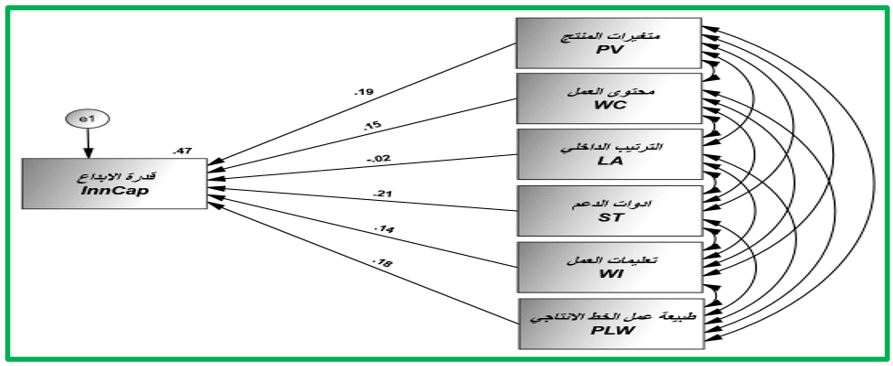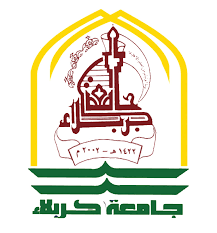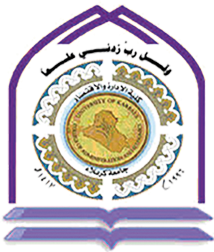تأثير تعقيد الإنتاج المدرك في قدرة الإبداع (بحث تحليلي في دار الوارث للطباعة والنشر – كربلاء المقدسة)
الكلمات المفتاحية:
تعقيد الإنتاج المدرك، قدرة الإبداع، دار الوارث للطباعة والنشر.الملخص
يهدف البحث بصورة أساسية إلى تحديد تأثير تعقيد الإنتاج المدرك بأبعاده الفرعية في قدرة الإبداع على مستوى العينة، وانطلاقا من مشكلة رئيسة تم تشخيصها بعدة تساؤلات تضمنت مدى إدراك العلاقات التأثيرية بين المتغيرات ميدانيا فقد اعتمد البحث أنموذج (Mattsson ,et al, 2016 : 9) لقياس تعقيد الإنتاج المدرك وأنموذج (Kafetzopoulos & Psomas, 2015 : 129) لقياس قدرة الإبداع. وتكونت عينة البحث من (110) فرداً توزعوا على الخطوط الإنتاجية، وتم تحليل البيانات باستخدام البرنامج الاحصائي، (SPSS.V.27)، وتوصل البحث إلى مجموعة من الاستنتاجات منها (أن بعد الترتيب الداخلي كان تأثيره غير معنوي وغير فعال في احداث تحسين ملموس في قدرة الإبداع).
المراجع
Alkan, B., Vera, D., Ahmad, M., Ahmad, B., & Harrison, R. (2016). A model for complexity assessment in manual assembly operations through predetermined motion time systems. Procedia Cirp, 44, 429-434.
Bäckström, C., & Nebel, B. (1995). Complexity results for SAS+ planning. Computational Intelligence, 11(4), 625-655.
Battini, D., Delorme, X., Dolgui, A., Persona, A., & Sgarbossa, F. (2016). Ergonomics in assembly line balancing based on energy expenditure: a multi-objective model. International Journal of Production Research, 54(3), 824-845.
Bengel, P. T., & Peter, C. (2023). Technology in Nature—mDGBL as a Successful Approach to Promote Complex Contents?. Sustainability, 15(1), 633.
Bengel, P. T., & Peter, C. (2023). Technology in Nature—mDGBL as a Successful Approach to Promote Complex Contents?. Sustainability, 15(1), 633.
Calinescu, A., Efstathiou, J., Schirn, J., & Bermejo, J. (1998). Applying and assessing two methods for measuring complexity in manufacturing. Journal of the Operational Research Society, 49(7), 723-733.
Chen, X., & Meurers, D. (2016). CTAP: A web-based tool supporting automatic complexity analysis.
Crossan, M. M., & Apaydin, M. (2010). A multi‐dimensional framework of organizational innovation: A systematic review of the literature. Journal of management studies, 47(6), 1154-1191.
Crossan, M. M., & Apaydin, M. (2010). A multi‐dimensional framework of organizational innovation: A systematic review of the literature. Journal of management studies, 47(6), 1154-1191.
Domshlak, C. (2013, June). Fault tolerant planning: Complexity and compilation. In Proceedings of the International Conference on Automated Planning and Scheduling (Vol. 23, pp. 64-72).
Ekman, U. (2018). Smart city planning: Complexity. International Journal of E-Planning Research (IJEPR), 7(3), 1-21.
Essmann, H. E. (2009). Toward innovation capability maturity (Doctoral dissertation, Stellenbosch: University of Stellenbosch).
Fast-Berglund, Å., & Blomb, E. (2020). Evaluating ICT-tools for knowledge sharing and assembly support. Advances in The Ergonomics in Manufacturing: Managing the Enterprise of the Future, 106.
Fast-Berglund, A., & Stahre, J. (2013). Task allocation in production systems–Measuring and Analysing Levels of Automation. IFAC Proceedings Volumes, 46(15), 435-441.
Fisher, M. L., & Ittner, C. D. (1999). The impact of product variety on automobile assembly operations: Empirical evidence and simulation analysis. Management science, 45(6), 771-786.
Geisler, C. (2018). Coding for language complexity: The interplay among methodological commitments, tools, and workflow in writing research. Written Communication, 35(2), 215-249.
Grieco, A. A. D. M. (2017). Does social capital dimensions foster innovation capabilities? (Doctoral dissertation
Gullander, P., Davidsson, A., Dencker, K., Fasth, Å., Fässberg, T., Harlin, U., & Stahre, J. (2011). Towards a production complexity model that supports operation, re-balancing and man-hour planning. In Proceedings of the 4th Swedish Production Symposium (SPS): Lund, Sweden
Gunday, G., Ulusoy, G., Kilic, K., & Alpkan, L. (2011). Effects of innovation types on firm performance. International Journal of production economics, 133(2), 662-676.
Hanaysha, J. R., Al-Shaikh, M. E., Joghee, S., & Alzoubi, H. M. (2022). Impact of innovation capabilities on business sustainability in small and medium enterprises. FIIB Business Review, 11(1), 67-78.
Hanaysha, J. R., Al-Shaikh, M. E., Joghee, S., & Alzoubi, H. M. (2022). Impact of innovation capabilities on business sustainability in small and medium enterprises. FIIB Business Review, 11(1), 67-78.
Hansen, M. T., Nohria, N., & Tierney, T. (2013). What's your strategy for managing knowledge?. In The knowledge management yearbook 2000-2001, (pp. 55-69). Routledge.
Hawking, S., & Dolby, T. (2000). What is complexity?. The Washington Center for Complexity
Hazır, Ö. (2015). A review of analytical models, approaches and decision support tools in project monitoring and control. International Journal of Project Management, 33(4), 808-815.
Hiong, L. S., Ferdinand, A. T., & Listiana, E. (2020). Techno-resonance innovation capability for enhancing marketing performance: a perspective of RA-theory. Business: Theory and Practice, 21(1), 329-339.
Jalil, M. F., Ali, A., & Kamarulzaman, R. (2022). Does innovation capability improve SME performance in Malaysia? The mediating effect of technology adoption. The International Journal of Entrepreneurship and Innovation, 23(4), 253-267.
Kafetzopoulos, D., & Psomas, E. (2015). The impact of innovation capability on the performance of manufacturing companies: The Greek case. Journal of Manufacturing Technology Management.
Kogut, B., & Zander, U. (1992). Knowledge of the firm, combinative capabilities, and the replication of technology. Organization science, 3(3), 383-397.
Konz, S. A., & Dickey, G. L. (1969). Manufacturing assembly instructions; A summary. Ergonomics, 12(3), 369 -382.
Kool, W., Gershman, S. J., & Cushman, F. A. (2018). Planning complexity registers as a cost in metacontrol. Journal of cognitive neuroscience, 30(10), 1391-1404.
Lawson, B., & Samson, D. (2001). Developing innovation capability in organisations: a dynamic capabilities approach. International journal of innovation management, 5(03), 377-400.
Le, P. B., & Lei, H. (2019). Determinants of innovation capability: the roles of transformational leadership, knowledge sharing and perceived organizational support. Journal of knowledge management, 23(3), 527-547.
Lerro, A., Linzalone, R., & Schiuma, G. (2009). Modelling organisational innovation capability: A knowledge -based approach. Proceedings of the 4th IFKAD, 1-22.
Li, D., Mattsson, S., Salunkhe, O., Fast-Berglund, Å., Skoogh, A., & Broberg, J. (2018). Effects of information content in work instructions for operator performance. Procedia Manufacturing, 25, 628-635.
Li, K., & Wieringa, P. A. (2001). Structured operation environment and perceived complexity in human supervisory control. Asian Journal of control, 3(3), 181-189.
Martínez-Román, J. A., Gamero, J., & Tamayo, J. A. (2011). Analysis of innovation in SMEs using an innovative capability-based non-linear model: A study in the province of Seville (Spain). Technovation, 31(9), 459-475.
Mattsson, S. (2013). What is perceived as complex in final assembly? (Doctoral dissertation, Chalmers Tekniska Hogskola (Sweden))
Mattsson, S., Salunke, O., Fast-Berglund, Å., Li, D., & Skoogh, A. (2018). Design concept towards a human-centered learning factory. Procedia manufacturing, 25, 526-534
Mattsson, S., Tarrar, M., & Fast-Berglund, Å. (2016). Perceived production complexity–understanding more than parts of a system. International Journal of Production Research, 54(20), 6008-6016.
Mattsson, S., Tarrar, M., & Harari, N. S. (2020). Using the compleXity index for improvement work: investigating utilisation in an automotive company. International Journal of Manufacturing Research, 15(1), 3-21.
McMahon, C., Lowe, A., & Culley, S. (2004). Knowledge management in engineering design: personalization and codification. Journal of Engineering Design, 15(4), 307-325.
Mitariani, N., Yasa, N., Giantari, I., & Setiawan, P. (2023). Improving export performance trough innovation capability during COVID-19 pandemic: The mediation role of aesthetic-utilitarian value and positional advantage. Uncertain Supply Chain Management, 11(1), 361-374.
Munir, M., Arief, M., Abdinagoro, S. B., & Furinto, A. (2022). Building sustainable collaboration through effective leadership sustainability mediated by innovation capability and moderated by external stakeholder interest: Case study in Indonesia Social Security Administration Agency. ITALIENISCH, 12(1), 279-294.
Novak, S., & Eppinger, S. D. (2001). Sourcing by design: Product complexity and the supply chain. Management science, 47(1), 189-204.
Perdomo-Ortiz, J., González-Benito, J., & Galende, J. (2006). Total quality management as a forerunner of business innovation capability. Technovation, 26(10), 1170-1185.
Phuong, L. N., Tuan, K. C., Duc, N. N., & Thi, U. N. (2022). The Impact of Absorption Capability, Innovation Capability, and Branding Capability on Firm Performance—An Empirical Study on Vietnamese Retail Firms. Sustainability, 14(11), 6422.
Raghuvanshi, J., & Garg, C. P. (2022). Shaping the handicraft cluster through innovation capability. International Journal of Innovation Studies, 6(2), 102-117.
Rajapathirana, R. J., & Hui, Y. (2018). Relationship between innovation capability, innovation type, and firm performance. Journal of Innovation & Knowledge, 3(1), 44-55.
Romero, D., Mattsson, S., Fast-Berglund, Å., Wuest, T., Gorecky, D., & Stahre, J. (2018). Digitalizing occupational health, safety and productivity for the operator 4.0. In Advances in Production Management Systems. Smart Manufacturing for Industry 4.0: IFIP WG 5.7 International Conference, APMS 2018, Seoul, Korea, August 26-30, 2018, Proceedings, Part II (pp. 473-481). Springer International Publishing.
Rubilar, C. M. (2019). Designing of augmented reality teaching-learning sequences to promote the accessibility and vizualization of complex contents in Chemistry. In EDULEARN19 Proceedings (pp. 8299-8303). IATED.
Saunila, M., Pekkola, S., & Ukko, J. (2014). The relationship between innovation capability and performance: The moderating effect of measurement. International Journal of Productivity and Performance Management, 63(2), 234-249.
Schuh, G., Rudolf, S., Riesener, M., Dölle, C., & Schloesser, S. (2017). Product production complexity research: developments and opportunities. Procedia CIRP, 60, 344-349.
Shim, J. P., Warkentin, M., Courtney, J. F., Power, D. J., Sharda, R., & Carlsson, C. (2002). Past, present, and future of decision support technology. Decision support systems, 33(2), 111-126.
Sikorra, J. N., Friedewald, A., & Lödding, H. (2016). Early estimation of work contents for planning the one-of-a-kind production by the example of shipbuilding. In MATEC Web of Conferences, (Vol. 77, p. 01025). EDP Sciences.
Slater, S. F., Mohr, J. J., & Sengupta, S. (2014). Radical product innovation capability: Literature review, synthesis, and illustrative research propositions. Journal of product innovation management, 31(3), 552-566.
Strønen, F., Hoholm, T., Kværner, K. J., & Støme, L. N. (2017). Dynamic capabilities and innovation capabilities: The case of the ‘Innovation Clinic’. Journal of Entrepreneurship, Management and Innovation, 13(1), 89-116.
Urbanic, R. J., & ElMaraghy, W. H. (2006). Modeling of manufacturing process complexity. Advances in Design, 425-436.
Valdeza, A. C., Braunera, P., Schaara, A. K., Holzingerb, A., & Zieflea, M. (2015, August). Reducing complexity with simplicity-usability methods for industry 4.0. In Proceedings 19th triennial congress of the IEA (Vol. 9, p. 14).
Vu, H. M. (2020). A review of dynamic capabilities, innovation capabilities, entrepreneurial capabilities and their consequences. The Journal of Asian Finance, Economics and Business, 7(8), 485-494.
Wang, C. L., & Ahmed, P. K. (2007). Dynamic capabilities: A review and research agenda. International journal of management reviews, 9(1), 31-51.
Zhu, Y., He, G., & Bao, K. (2022). Driving Path and System Simulation of Green Innovation Capability of Science and Technology Enterprises in Yangtze River Delta. Sustainability, 14(20), 13031.

التنزيلات
منشور
كيفية الاقتباس
إصدار
القسم
الرخصة
الحقوق الفكرية (c) 2024 ذكاء ضياء السلطاني، عادل عباس الجنابي، محمد تركي عبدالعباس

هذا العمل مرخص بموجب Creative Commons Attribution-NonCommercial-NoDerivatives 4.0 International License.
يحتفظ المؤلفون بحقوق الطبع والنشر لأوراقهم دون قيود.









